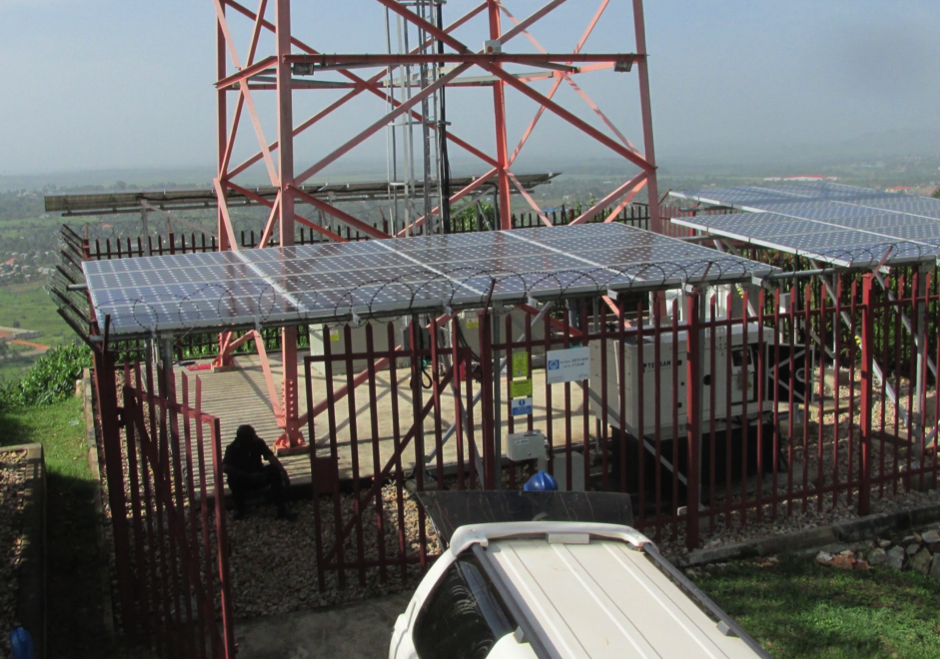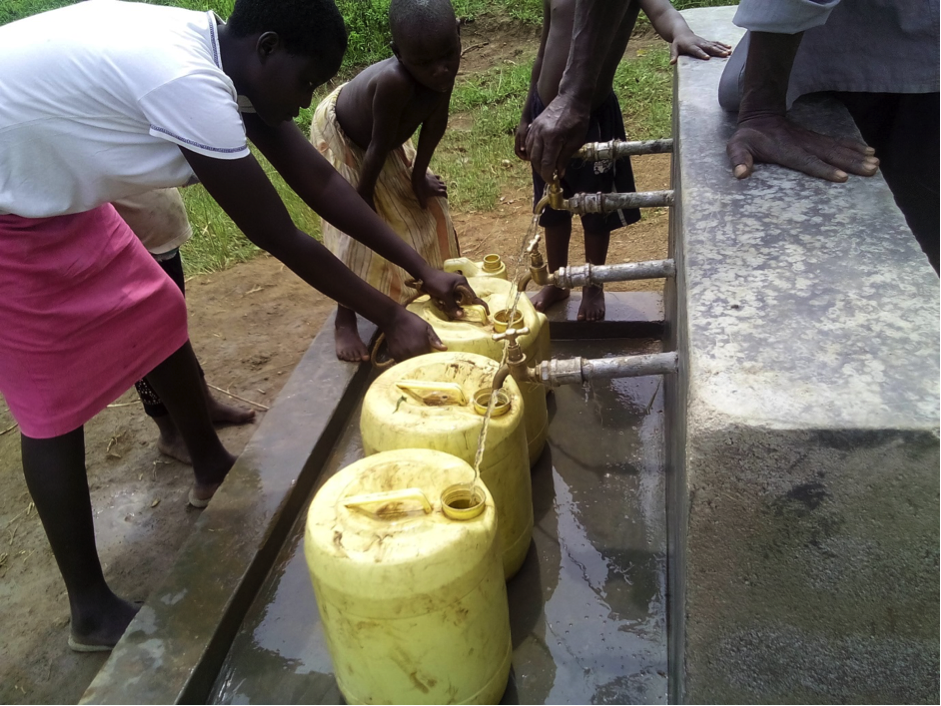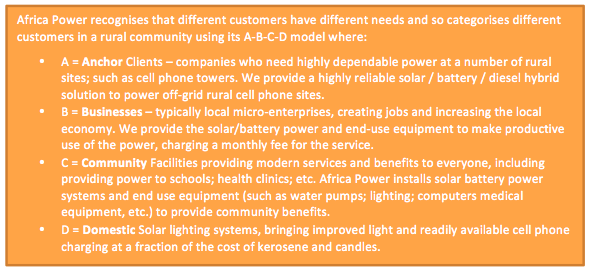The A-B-C-D of rural electrification
The A-B-C-D of rural electrification
A systematised approach to a CDKN-supported project has seen the promising demonstration of an off-grid, rural power service model in Uganda. Dr Alastair Livesey, Managing Director of Africa Power, explains how the CDKN pilot project provided power services to a wide range of customers based on its A-B-C-D Rural Electrification model.
Fewer than 20% of rural Ugandans have access to electricity, inhibiting development and income growth. The low population densities and low purchasing power in these communities means the extension of the national grid is not viable.
While renewable power systems have been developed and tested in Africa, including a wide range of purely domestic solar home systems, no one has created a business model to provide remote off-grid community power to all potential customers in Africa on a commercial basis.
It was with this challenge in mind that a CDKN project supported Africa Power Ltd in rolling out its unique A-B-C-D system in partnership with Sincro SiteWatch, BBoxx, Divi-Power, GreenLight Planet and Cambridge Power Systems.
Part of CDKN’s Business Partnership, this sub-Saharan project aimed to address power issues by proving the viability of a distributed village power model. The project has installed and tested each strand of the A-B-C-D system in Uganda thus providing renewable power to a pilot village as well as demonstrating progress towards raising further funds to create an off-grid rural power company.
The project provided promising results in four major areas:
- The Anchor customer was a cell phone site on a hill near Seeta about one hour East of Kampala. The upgraded power system, reduced diesel consumption by 90%
- The Business sector was represented by an drip-feed irrigation project, allowing the farmer to plant high value tomato crops in the drier season when prices are higher
- The project pumped clean drinking water from a borehole and demonstrated the benefits power can bring to a Community Facility.
- Finally domestic solar lighting systems were distributed on a credit basis (pay as you go).
The last three interventions were all completed in a single, small hamlet called Buwofo, situated about four hours east of Kampala and about two hours west of the Kenyan border.
Cell phone towers (Anchor segment)
 Cell phone towers demand a high standard of power reliability – between 99.95 and 99.98% availability of power. This equates to less than two to five hours of electrical outage per year - a level of service seldom met by a national grid. In order to achieve this and avoid major penalties for defaulting, the project saw the upgrading of the Seeta Tower to a near full solar solution, reducing diesel consumption (and its associated theft and CO2 emissions) by over 90%. Seeta tower is installed on the top of a hill, just above the Seeta High School and is located about an hour East of Kampala. The small area of the site prevented deployment of sufficient solar panels to create a full-solar solution, and so a solar, battery and diesel hybrid solution was specified and installed.
Cell phone towers demand a high standard of power reliability – between 99.95 and 99.98% availability of power. This equates to less than two to five hours of electrical outage per year - a level of service seldom met by a national grid. In order to achieve this and avoid major penalties for defaulting, the project saw the upgrading of the Seeta Tower to a near full solar solution, reducing diesel consumption (and its associated theft and CO2 emissions) by over 90%. Seeta tower is installed on the top of a hill, just above the Seeta High School and is located about an hour East of Kampala. The small area of the site prevented deployment of sufficient solar panels to create a full-solar solution, and so a solar, battery and diesel hybrid solution was specified and installed.
Safe drinking water
The water project evolved over the life of the project. Initially, we sought to open a new well near the most fertile fields to provide drip-feed irrigation for up to half an acre of a high-yield, high-value tomato crop. However, during the geological survey stage, the charity-provided hand-pump had irretrievably corroded beyond economic repair. We thus devised a solution to pump and share the water from the borehole between the irrigation needs half a kilometre away and providing safe, clean drinking water from a tap on demand in the hamlet. The project was redesigned and managed to come in on budget providing both a business and community use for the water.
The water project provided unexpected engineering challenges. High-efficiency, solar-powered water-pumps assume an unlimited water source, and vary their pumping rate according to the availability of sunlight. Tests at the village borehole, showed that the borehole had a limited flow rate. To achieve the volumes of water required for both the community and business use (drip-feed irrigation) necessitates pumping 16 hours a day – long after the sun has set.
The engineers rose to the challenge, completing a power solution which:
- Added batteries to pump through the night, and
- Added a mechanism to restrict the maximum flow rate to match the borehole’s capacity.
 The system has run continuously without fault from installation. Villagers no longer depend on contaminated water seepage and have clean, safe water on tap within the village boundary.
The system has run continuously without fault from installation. Villagers no longer depend on contaminated water seepage and have clean, safe water on tap within the village boundary.
Sustainable water supply for high value crops through drip irrigation
Drip irrigation can have a significant impact on the profitability of small-holder farmers. Uganda typically has two rains: the big rains and small rains. Whilst fruit and vegetables, which yield a higher value per acre than staple crops, can be grown in the big rains, over abundance at harvest time causes prices to fall. High-value crops such as tomatoes can be planted in the hope of a successful “small rains” season crop, but the yields are low and unpredictable, with many years providing limited or no crops, just when prices are high because of limited availability.
Drip irrigation allows continuous cropping with three to four cropping rotations per year using high- yield varieties, as opposed to lower yield (so called drought-resistant) varieties.
Furthermore, crops can be timed to avoid the low-prices in the rainy season and so command higher prices in the markets. Thus the farmer gains a triple benefit of being able to plant high-value, high yield crops and harvest and sell these when prices are high.
Although the area of drip-feed irrigation is small, the ability to grow high-value market-garden produce when they command the highest value gives small-holders a valuable additional income over and above the pay-as-you-go fees for the water pumping.
Provision of pay-as-you-go domestic solar lighting
Solar Home Systems provide high-quality lighting and cell phone charging for households. These systems were provided on a “pay-as-you-go” basis in the project. The “pay-as-you-go” fees, whilst commercially sustainable, provide a saving compared to the cost of kerosene and candles for light and regular trips to town to recharge cell phones. The kerosene lamps provided low and flickering light levels, and give off large amounts of heat and soot, increasing the incidence of respiratory diseases, especially amongst women and girls who spend more time indoors.
We found there was a need for a wide range of solar home systems in the community and a desire to gradually increase the capabilities of the systems over time on a steady pay-as-you-go fee. We thus tested a wider range of solar lighting systems than originally envisaged, sourcing these from multiple suppliers. In our model, villagers pay $2/week for the above systems, without needing to pay a deposit. After 18 months the villagers own the systems outright or can upgrade the system and continue to pay for a further contracted period. Some villagers can afford higher payments and seek more lights; radios, music players, televisions and even fridges. Customers wanted to be able to upgrade their systems and were willing to continue to pay so that over-time, and on an affordable plan, they could gain the benefits of full electrification.
Next Steps
The pilot project demonstrated that off-grid rural power services are technically viable and the costs involved met our expectations. Detailed financial modelling based on, and completed as part of, this pilot has shown that a distributed off-grid rural power services company can be viable in Africa at sufficient scale and provide good returns for impact investors when supported by development funds to provide the initial scale-up to reach profitability. Africa Power Ltd and its partners are seeking development funding and impact investors to scale the project to provide power to half a million people and businesses in each of Uganda, Tanzania and Zambia over 5 years.
The project taught us valuable lessons on an improved cost structure, the complexities around the management of water, including permitting, ownership and village expectations and demonstrated there is a more varied market demand for power services than we had anticipated. All the findings from the pilot study have been incorporated into the business plans being rolled out in neighbouring Tanzania and under development for Zambia.
For further information contact: aLivesey@AfricaPowerLtd.com

